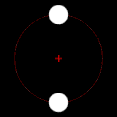
Back مرجح Arabic Baricentru AST সাধারণ ভরকেন্দ্র (জ্যোতির্বিজ্ঞান) Bengali/Bangla Barycentrum Czech Барицентр CV Barycentrum Danish Baryzentrum German Baricentro Spanish مرکز سنگینی سراسری Persian Baricentro (astronomía) Galician
| Part of a series on |
| Astrodynamics |
|---|
In astronomy, the barycenter (or barycentre; from Ancient Greek βαρύς (barús) 'heavy' and κέντρον (kéntron) 'center')[1] is the center of mass of two or more bodies that orbit one another and is the point about which the bodies orbit. A barycenter is a dynamical point, not a physical object. It is an important concept in fields such as astronomy and astrophysics. The distance from a body's center of mass to the barycenter can be calculated as a two-body problem.
If one of the two orbiting bodies is much more massive than the other and the bodies are relatively close to one another, the barycenter will typically be located within the more massive object. In this case, rather than the two bodies appearing to orbit a point between them, the less massive body will appear to orbit about the more massive body, while the more massive body might be observed to wobble slightly. This is the case for the Earth–Moon system, whose barycenter is located on average 4,671 km (2,902 mi) from Earth's center, which is 74% of Earth's radius of 6,378 km (3,963 mi). When the two bodies are of similar masses, the barycenter will generally be located between them and both bodies will orbit around it. This is the case for Pluto and Charon, one of Pluto's natural satellites, as well as for many binary asteroids and binary stars. When the less massive object is far away, the barycenter can be located outside the more massive object. This is the case for Jupiter and the Sun; despite the Sun being a thousandfold more massive than Jupiter, their barycenter is slightly outside the Sun due to the relatively large distance between them.[2]
In astronomy, barycentric coordinates are non-rotating coordinates with the origin at the barycenter of two or more bodies. The International Celestial Reference System (ICRS) is a barycentric coordinate system centered on the Solar System's barycenter.
- ^ "barycentre". Oxford English Dictionary (2nd ed.). Oxford University Press. 1989.
- ^ Cite error: The named reference
MacDougalwas invoked but never defined (see the help page).




